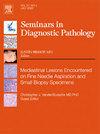Non-invasive Lobular Neoplasia: Review and Updates
IF 3.5
3区 医学
Q2 MEDICAL LABORATORY TECHNOLOGY
引用次数: 0
Abstract
Non-invasive lobular neoplasia (LN) encompasses atypical lobular hyperplasia (ALH), classic lobular carcinoma in situ (CLCIS), florid lobular carcinoma in situ (FLCIS), and pleomorphic lobular carcinoma in situ (PLCIS). Lobular neoplasia is a neoplastic epithelial proliferation of the terminal duct lobular unit. A defining feature is discohesion due to the loss of E-cadherin, a protein that facilitates cell-to-cell adhesion. Lobular neoplasia is both a risk factor and a non-obligate precursor of invasive breast carcinoma. Classic LN, characterized by small, non-cohesive monomorphic cells, includes ALH and classic LCIS. While classic LN is usually not seen on imaging and, therefore, is diagnosed incidentally, FLCIS and PLCIS are typically the imaging targets, most often manifesting as calcifications. Unlike classic LN, which is typically hormone receptor-positive and HER2-negative, FLCIS and PLCIS may present with less favorable phenotypes. While ALH and CLCIS diagnosed on concordant core biopsy are generally managed with surveillance with or without chemoprevention, complete surgical excision is recommended for FLCIS and PLCIS due to high upgrade rates to invasive carcinoma. Accurate classification of non-invasive breast neoplastic lesions is essential for guiding treatment. This review provides an overview of the clinical features, pathology, and management of lobular neoplasia, emphasizing the importance of accurate diagnosis and individualized patient care.
非侵袭性小叶肿瘤:回顾和最新进展。
非侵袭性小叶肿瘤(LN)包括非典型小叶增生(ALH)、典型小叶原位癌(CLCIS)、花状小叶原位癌(FLCIS)和多形性小叶原位癌(PLCIS)。小叶肿瘤是小叶末端导管上皮的肿瘤增生。一个决定性的特征是由于e -钙粘蛋白(一种促进细胞间粘附的蛋白质)的丢失而导致的分离。小叶肿瘤是浸润性乳腺癌的危险因素和非专性前兆。典型LN包括ALH和典型LCIS,其特征是小而非内聚的单形细胞。虽然典型LN通常在影像学上不可见,因此是偶然诊断的,但FLCIS和PLCIS是典型的影像学目标,最常表现为钙化。与典型的激素受体阳性和her2阴性的经典LN不同,FLCIS和PLCIS可能表现出不太有利的表型。虽然通过一致性核心活检诊断出的ALH和CLCIS通常在有或没有化学预防的情况下进行监测,但由于FLCIS和PLCIS向浸润性癌的高升级率,建议对其进行完全手术切除。乳腺非侵袭性肿瘤病变的准确分类对指导治疗至关重要。本文综述了小叶肿瘤的临床特点、病理和治疗,强调了准确诊断和个体化治疗的重要性。
本文章由计算机程序翻译,如有差异,请以英文原文为准。
求助全文
约1分钟内获得全文
求助全文
来源期刊
CiteScore
4.80
自引率
0.00%
发文量
69
审稿时长
71 days
期刊介绍:
Each issue of Seminars in Diagnostic Pathology offers current, authoritative reviews of topics in diagnostic anatomic pathology. The Seminars is of interest to pathologists, clinical investigators and physicians in practice.

 求助内容:
求助内容: 应助结果提醒方式:
应助结果提醒方式:


